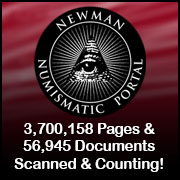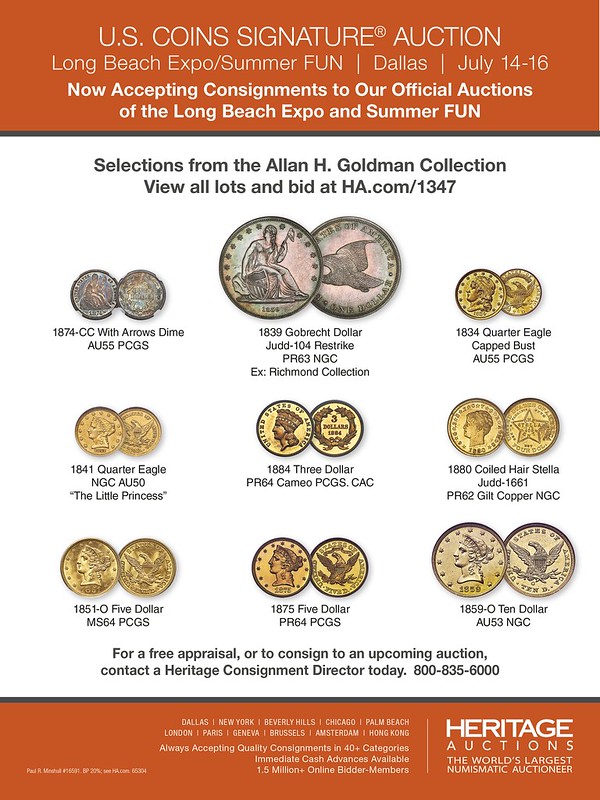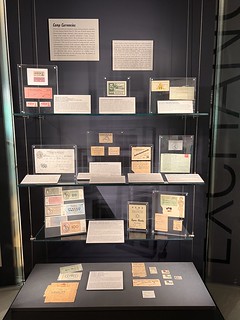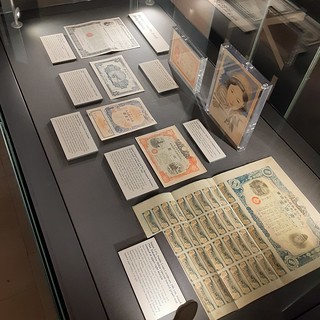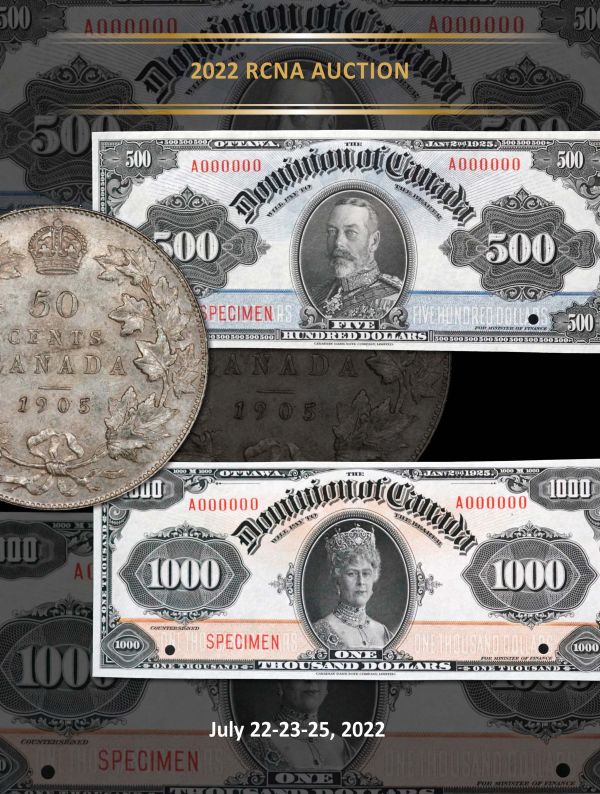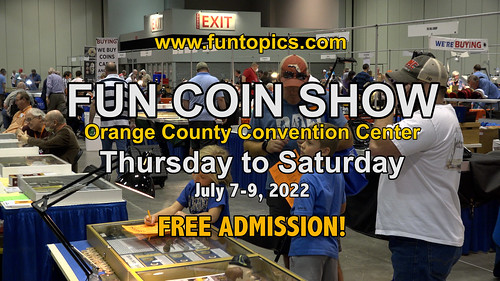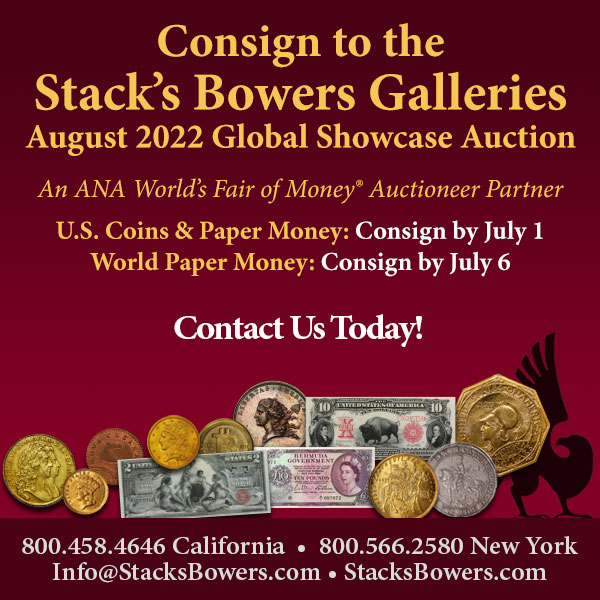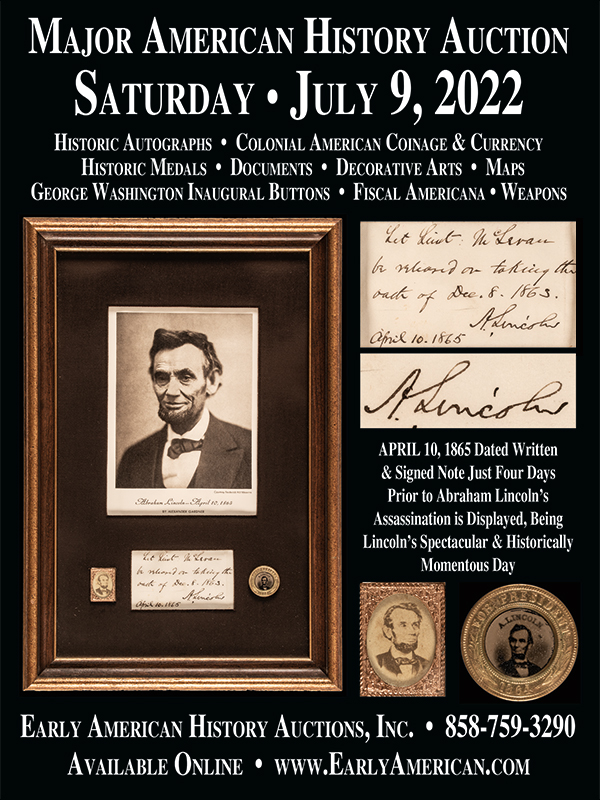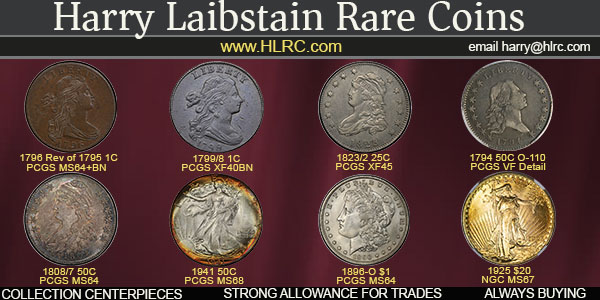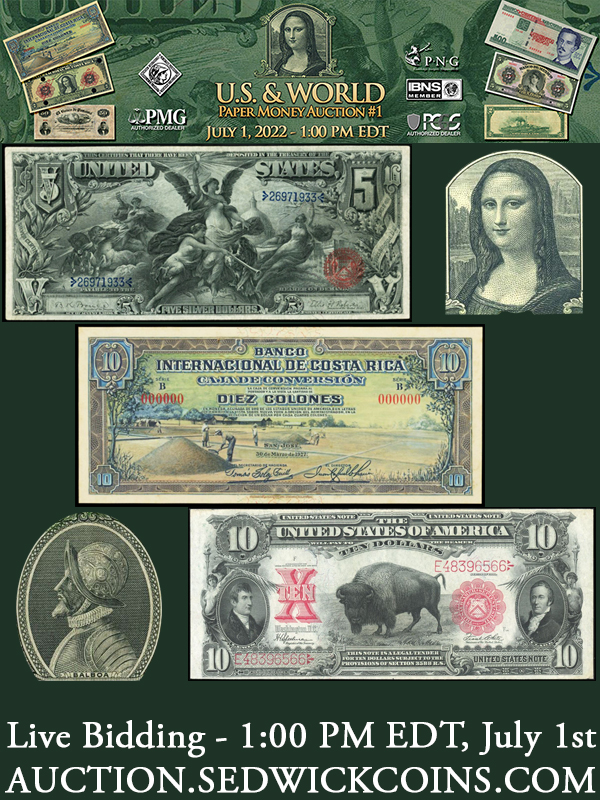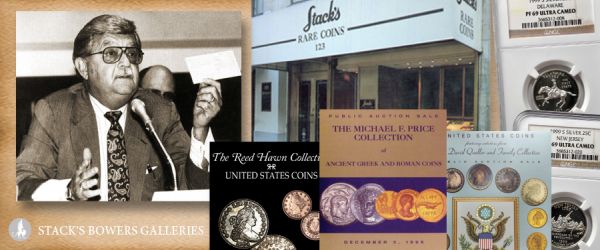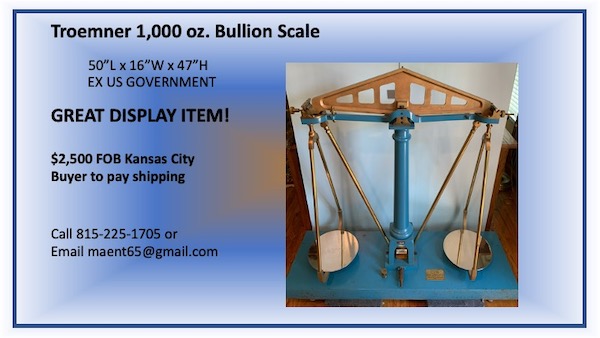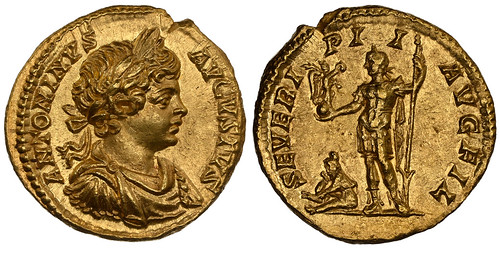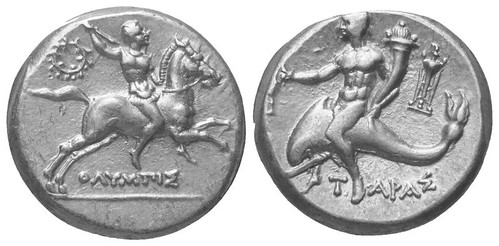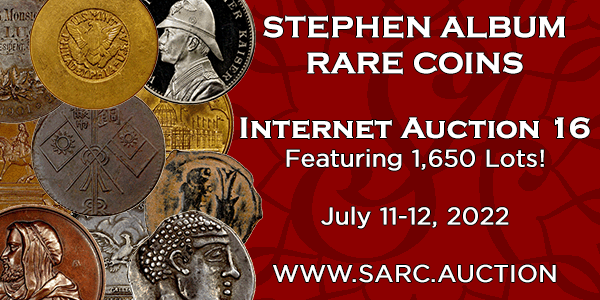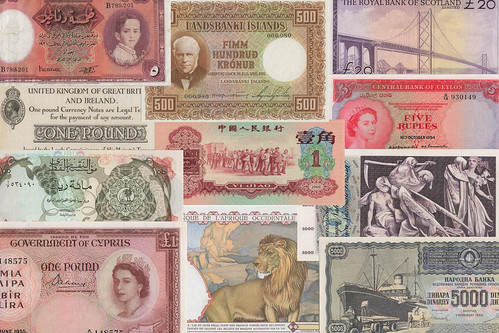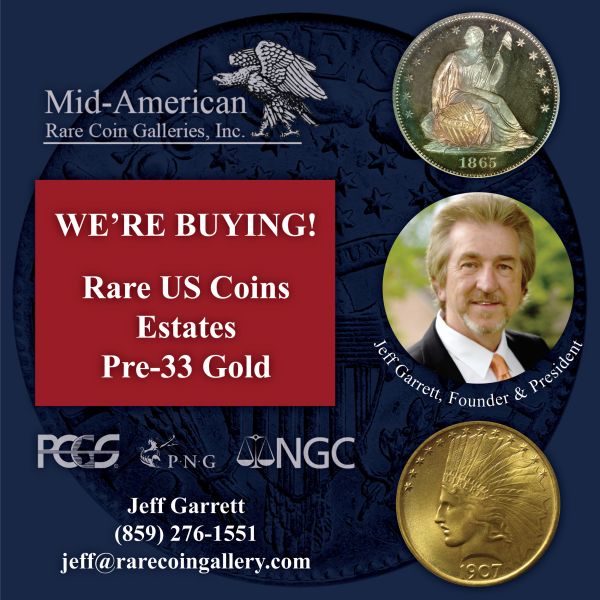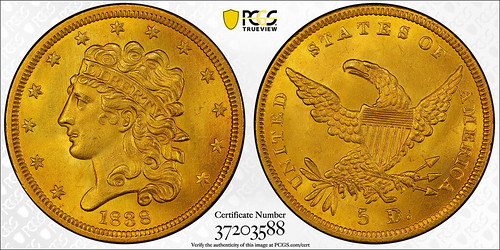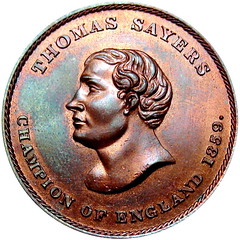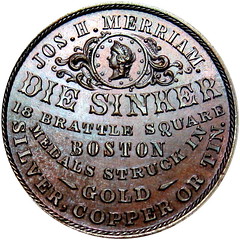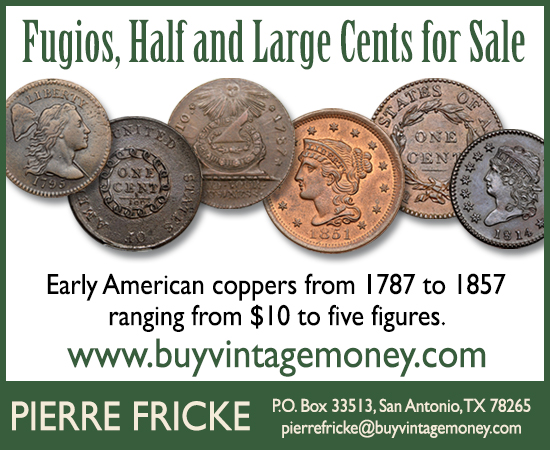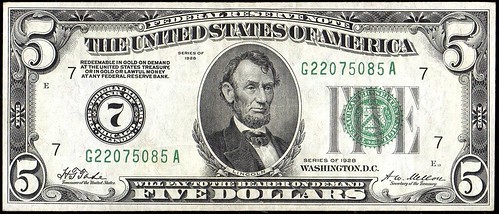
Visit our NBS Sponsors


About UsThe Numismatic Bibliomania Society is a non-profit association devoted to the study and enjoyment of numismatic literature. For more information please see our web site at coinbooks.org SubscriptionsThose wishing to become new E-Sylum subscribers (or wishing to Unsubscribe) can go to the following web page link MembershipThere is a membership application available on the web site Membership Application To join, print the application and return it with your check to the address printed on the application. Print/Digital membership is $40 to addresses in the U.S., and $60 elsewhere. A digital-only membership is available for $25. For those without web access, write to: Charles Heck, Treasurer AsylumFor Asylum mailing address changes and other membership questions, contact Chuck at this email address: treasurer@coinbooks.org SubmissionsTo submit items for publication in The E-Sylum, write to the Editor at this address: whomren@gmail.com BUY THE BOOK BEFORE THE COINSale CalendarWatch here for updates! |
- WAYNE'S WORDS: THE E-SYLUM JUNE 26, 2022
- NEW BOOK: MEDALS OF THE ROYAL CANADIAN MINT
- NEW BOOK: GERMAN NOTGELD, VOLUME 10
- DONALD CLYDE KELLY (1933-2022)
- NNP DIGITIZES ANS MEMBER CORRESPONDENCE
- WASHINGTON UNIVERSITY STORIES FROM WWII
- VIDEO: 2022 SUMMER FUN SHOW COMMERCIAL
- MORE ON GARY SNOVER
- NOTES FROM E-SYLUM READERS: JUNE 26, 2022
- NORTHWEST TERRITORIAL MINT SENTENCES
- U. S. MINT CANVAS BAGS
- MORE ON ZERBE AND THE 1909 ANA ELECTION
- VOCABULARY TERM: JUGATE
- FRANK JOHN JOSEPH (1838-1895)
- HARVEY STACK'S NUMISMATIC FAMILY, PART 124
- ROSA AMERICANA COLONIAL COINS PRICE LIST #23
- ATLAS NUMISMATICS JULY 2022 SELECTIONS
- SOVEREIGN RARITIES AUCTION 6 HIGHLIGHTS
- SOLIDUS AUCTION 102 SELECTIONS
- WORLD BANKNOTE AUCTIONS SALE 28
- CLASSIC GOLD QUARTER EAGLE AND HALF EAGLES
- NUMISMATIC NUGGETS: JUNE 26, 2022
- WAYNE'S NUMISMATIC DIARY: JUNE 26, 2022
- NUMISMATIC COMMEMORATIONS OF PRIDE
- EAST INDIA COMPANY GODDESS HERA GOLD COIN
- TIFFANY COMMISSION SCRIP
- BRITAIN'S SWITCH TO POLYMER BANKNOTES
- FEDERAL RESERVE NOTE GOLD BACKING
- THE WAL-MART COIN-COVERED CADILLAC
Click here to read the thin version on the web
Click here to subscribe
Click here to access the complete archive
To comment or submit articles, reply to whomren@gmail.com
Content presented in The E-Sylum is not necessarily researched or independently fact-checked, and views expressed do not necessarily represent those of the Numismatic Bibliomania Society.
WAYNE'S WORDS: THE E-SYLUM JUNE 26, 2022
 New subscribers this week include:
James Mchugh.
Welcome aboard!
New subscribers this week include:
James Mchugh.
Welcome aboard!
Thank you for reading The E-Sylum. If you enjoy it, please send me the email addresses of friends you think may enjoy it as well and I'll send them a subscription. Contact me at whomren@gmail.com anytime regarding your subscription, or questions, comments or suggestions about our content.
This week we open with two new books, an obituary, updates from the Newman Numismatic Portal, notes from readers, and more.
Other topics this week include Royal Canadian Mint medals, Summer FUN, U.S. Mint canvas bags, Zerbe and the 1909 ANA election, fixed price and auction previews galore, numismatic commemorations of Pride, Tiffany Commission Scrip, and the coin-covered Cadillac.
To learn more about German notgeld, Don Kelly, Gary Snover, Gutzon Borglum, Ross Hansen, Joel Iskowitz, jugates, the Schoonmaker Family Collection, the 5th US Colored Troops, the "gay loonie" and "pink money", read on. Have a great week, everyone!
Wayne Homren
Editor, The E-Sylum
NEW BOOK: MEDALS OF THE ROYAL CANADIAN MINT
Alan Roy submitted this announcement of his new book on Royal Canadian Mint medals and exonumia. Thanks, and congratulations! Alan can be reached by email at alroy477@gmail.com . -Editor
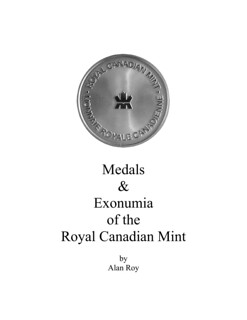 I have finally finished my passion project just in time to make it available at the Royal Canadian Numismatic Association's upcoming annual convention in Ottawa on July 20-24.
I have finally finished my passion project just in time to make it available at the Royal Canadian Numismatic Association's upcoming annual convention in Ottawa on July 20-24.
"The Medals & Exonumia of the Royal Canadian Mint" is a 138-page listing of medals issued by Canada's national mint during it's more than one hundred years of operation. It includes all known medals made and distributed by the mint. These include pieces sold directly to the public, issued in conjunction with events sponsored by the mint, and distributed at meetings or trade shows. It also includes medals issued as tokens of appreciation to employees. Another section of the catalogue lists medals featuring the Royal Canadian Mint as a theme.
NEW BOOK: GERMAN NOTGELD, VOLUME 10
Here's a Google-translated description of the announcement of a new volume on German Notgeld by Hans Ludwig Grabowski. -Editor
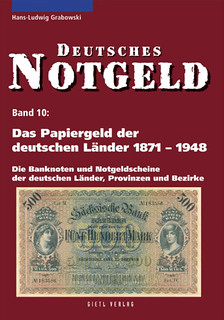 Hans Ludwig Grabowski:
Hans Ludwig Grabowski:
German Notgeld, Volume 10: The paper money of the German states 1871-1948
The banknotes and emergency money notes of the German states, provinces and districts
3rd edition 2022
approx. 750 pages, illustrated in color throughout,
Format 14.8 cm x 21 cm, paperback,
ISBN: 978-3-86646-581-7
Price: 59.80 euros
Release date: early November 2022
THE BOOK BAZARRE
DONALD CLYDE KELLY (1933-2022)
Jerry Fochtman notified me of the passing of paper money researcher and author Don C. Kelly. Here's an excerpt from his online obituary. -Editor
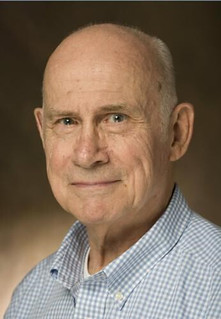 Donald Clyde Kelly was born August 18, 1933 in Poland, Ohio, the son of Pauline Gatrina Fetherolf Kelly and Leroy Clyde Kelly. He graduated from Poland Seminary High School in 1951. In 1955 Don married Jane Arlina Williams and they shared 67 wonderful years. Don loved Oxford - a great place to live, work, play, raise a family and grow old with your friends. He graduated from Miami University in 1955 and 1956 and Yale University in 1959. Don returned to Oxford in 1960 and taught at Miami for 33 years. Don is survived by his wife Jane and their four children...
Donald Clyde Kelly was born August 18, 1933 in Poland, Ohio, the son of Pauline Gatrina Fetherolf Kelly and Leroy Clyde Kelly. He graduated from Poland Seminary High School in 1951. In 1955 Don married Jane Arlina Williams and they shared 67 wonderful years. Don loved Oxford - a great place to live, work, play, raise a family and grow old with your friends. He graduated from Miami University in 1955 and 1956 and Yale University in 1959. Don returned to Oxford in 1960 and taught at Miami for 33 years. Don is survived by his wife Jane and their four children...
NNP DIGITIZES ANS MEMBER CORRESPONDENCE
The latest addition to the Newman Numismatic Portal is correspondence of American Numismatic Society members. Project Coordinator Len Augsburger provided the following report from NNP intern Kellen Hoard. -Editor
Newman Portal Digitizes ANS Member Correspondence
Newman Portal is currently digitizing ANS member correspondence from inception to the 1930s. Kellen Hoard reports on the file for the sculptor Gutzon Borglum that was recently scanned.
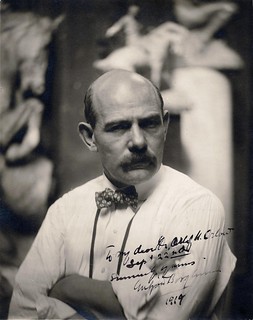 Gutzon Borglum—progeny of Mormon Danish immigrants, product of Parisian art schools, KKK member, friend of Theodore Roosevelt—was a sculptor in many mediums. His most famous work was in stone; it was he who oversaw the creation of Mount Rushmore, and he who launched the work on the Stone Mountain memorial before being fired. But he was also a capable artist in marble and bronze, including a numismatically-relevant statue of John William Mackay, a Bonanza King of the Comstock lode.
Gutzon Borglum—progeny of Mormon Danish immigrants, product of Parisian art schools, KKK member, friend of Theodore Roosevelt—was a sculptor in many mediums. His most famous work was in stone; it was he who oversaw the creation of Mount Rushmore, and he who launched the work on the Stone Mountain memorial before being fired. But he was also a capable artist in marble and bronze, including a numismatically-relevant statue of John William Mackay, a Bonanza King of the Comstock lode.
One medium he was less talented in was that of coinage. Borglum was charged with designing the 1925 Stone Mountain Memorial half dollar (after being a driving force behind its authorization), but his plaster models were rejected nine separate times by the Commission of Fine Arts, led by James Earle Fraser. The Commission generally considered his designs inartistic.
His case was not helped by the fact that, in the words of numismatists William D. Hyder and R.W. Colbert, Borglum, to put it mildly, was a temperamental artist who managed to offend most everyone with whom he worked.
WASHINGTON UNIVERSITY STORIES FROM WWII
Newman Numismatic Portal Project Coordinator Len Augsburger provided the following report on a new exhibit. Thanks. -Editor
Washington University Opens Stories from WWII Exhibit
VIDEO: 2022 SUMMER FUN SHOW COMMERCIAL
These are selections from the David Lisot Video Library that feature news and personalities from the world of coin collecting. David has been attending coin conventions since 1972 and began videotaping in 1985. The Newman Numismatic Portal now lists all David's videos on their website at:
https://nnp.wustl.edu/library/multimediadetail/522852
This one is the television commercial for the July 2022 Summer FUN Show. -Editor
Florida United Numismatists Summer Coin Convention 2022 Television Commercial
VIDEO: 00:30
MORE ON GARY SNOVER
Fred Schwan edits the MPCGram, an email newsletter for collectors of Military Payment Certificates and other military numismatica. In the latest issue, he remembers paper money dealer Gary Snover. With permission, we're publishing an excerpt here. -Editor
I do not know when Gary started dealing or collecting paper money, but he was established and well known when I started collecting MPC in 1973! At that time Gary was also collecting MPC. Throughout his career, Gary found things to collect that others did not. That is why he collected MPC--few collectors even knew what it was and virtually no one collected it. Very shortly thereafter Gary discontinued collecting MPC because too many people were doing it!
NOTES FROM E-SYLUM READERS: JUNE 26, 2022
On Numismatic Auctions and In-Person Bidding
Regarding the fate of live numismatic auctions, Stack's Bowers Galleries
Senior Numismatist and Auctioneer
Ben Orooji writes:
 "I am happy to report that Stack's Bowers Galleries has no intentions of eliminating live auctions. In fact, we've built a beautiful studio at our headquarters in Costa Mesa, CA specifically for the purposes of showing our live auctions all over the world in high definition that makes you feel as if you're
"I am happy to report that Stack's Bowers Galleries has no intentions of eliminating live auctions. In fact, we've built a beautiful studio at our headquarters in Costa Mesa, CA specifically for the purposes of showing our live auctions all over the world in high definition that makes you feel as if you're right there
even if you're watching on a screen. Of course if you would like to come to our studio and bid live in-person we will wholeheartedly welcome you and will have snacks, drinks and meals provided. Many bidders do so.
"Me and my fellow auctioneers and our studio managers keep working hard to make our live auctions exciting events that rival the best of the best art auction houses. We are confident when we say we think our live auctions are the finest among our numismatic competitors and invite you to watch them anytime. All of our recent sales are archived on YouTube. During the live auctions you can watch from our website, on our smartphone app, on YouTube and on Facebook Live."
It's a whole new world, and will take some getting used to. Having lot viewing at major shows with the auction itself taking place afterwards does make shows more relaxing. But for most bidders, travelling to a second location to bid in person is cost prohibitive. Yet as everyone's at-home technology and room setup improves, I think more bidders may be willing to drop their anonymity and fully participate in ways similar to the old style in-person sales (as Chris MacDowell recalls)- kibitzing, position-jockeying, trash-talking and cheering their fellow bidders as new records are set and new collections created and completed. The platforms aren't there yet, but such features could be possible one day. -Editor
Ben adds:
"You are correct that remote bidders cannot interact with each other on our platform. A major benefit here is that you are anonymous and a beginning collector has equal footing with the most seasoned among us. Yes, the
in-person trash talking is eliminated, but collectors can do the same over Facebook, the Collectors Universe forums or Discord channels if they like. It's a different experience for sure, but I'll be honest here: when I began collecting real
auction-worthy coins in the era of auctions in conjunction with shows I was incredibly intimidated. Today I wouldn't be of course, but I definitely would have appreciated the prevalence of online bidding while watching the sale that is currently the standard. To the dealers, this could present a disadvantage but I can't imagine a situation where this hurts the collector.
"Regardless, I'll submit your feedback and online interaction idea to the team here at SBG. Maybe there are others who are thinking along the same lines."
Good points. Just because technology COULD enable something doesn't always mean it SHOULD. I agree with Chris that something positive has been lost yet I'm glad there are already some alternate channels available. It just takes some coordination among the participants to initiate what happens naturally when a bunch of coin-crazed people are all in a physical room together. -Editor
Alan V Weinberg writes:
"I've attended live coin auctions since 1958 (Parke Bernet hotel 57th & 6th Ave NYC) and they've always been a major attraction at shows, attracting many collectors and dealers who otherwise might not have attended the show itself. With the catalogues themselves serving as reference material for many decades thereafter - like the John Ford auction series of nearly 30 separate auction catalogues.
"On the other hand, there is the solid argument that such on-site show auctions pull buyers off the bourse floor and cause potential bourse buyers to avoid spending on the bourse floor in favor of perhaps buying at the auction itself later that evening or even 1-2 days later.
"Additional auctioneer expenses at shows include large room rental and chair & table rentals, catered food & drinks for lunch/ dinner (more than a decade ago one major auctioneer told me a catered can of soda cost them $3 each THEN), per hour employees (likely working overtime) monitoring the bids, auctioneer expense, extra security, etc. There are considerable savings if only lot viewing occurs simultaneously with a show. Well, you say they get 20-25% buyers fee. Well, those fee figures are now a decade+ old and we all know what inflation has occurred.
"So, our concern now should be continued physical publication of the auction catalogues, NOT just online listings. There are so many arguments for keeping in-hand auction catalogues being issued. Stack's Bowers told me a decade ago that a major auction catalogue cost them, start to delivery, $35 each. Heritage has in-house publication and mailing so their costs may be somewhat less. But again that $35 per catalogue cost was over a decade ago. Mailing costs alone have skyrocketed."
To read the earlier E-Sylum article, see:
THE DEMISE OF LIVE AUCTIONS?
(https://www.coinbooks.org/v25/esylum_v25n25a14.html)
Other topics this week include Browning's Early Quarter Dollars, and a 1,000 oz. Bullion Scale. -Editor
NORTHWEST TERRITORIAL MINT SENTENCES
The U.S. Attorney's Office for the Western District of Washington announced the sentencing of the captured fugitive former executives of the Northwest Territorial Mint. -Editor
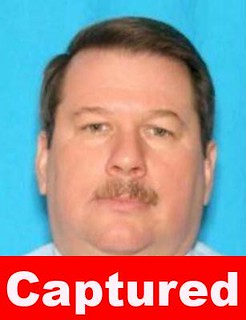 The former President & CEO of Northwest Territorial Mint, a now-bankrupt company dealing in precious metals, was sentenced today in U.S. District Court in Seattle to 11 years in prison for 14 federal felonies resulting from a Ponzi-like scheme that defrauded customers of millions of dollars, announced U.S. Attorney Nick Brown. Bernard Ross Hansen, 61, aka Ross B. Hansen was convicted of multiple counts of wire and mail fraud after a four-week jury trial in July 2021. Hansen's co-defendant and partner, Vault Manager Diane Renee Erdmann, 49, was convicted of 13 counts of wire fraud and mail fraud. She was sentenced to five years in prison. This was the second scheduled sentencing hearing for the two after they failed to show up for their late April court date and attempted to flee.
The former President & CEO of Northwest Territorial Mint, a now-bankrupt company dealing in precious metals, was sentenced today in U.S. District Court in Seattle to 11 years in prison for 14 federal felonies resulting from a Ponzi-like scheme that defrauded customers of millions of dollars, announced U.S. Attorney Nick Brown. Bernard Ross Hansen, 61, aka Ross B. Hansen was convicted of multiple counts of wire and mail fraud after a four-week jury trial in July 2021. Hansen's co-defendant and partner, Vault Manager Diane Renee Erdmann, 49, was convicted of 13 counts of wire fraud and mail fraud. She was sentenced to five years in prison. This was the second scheduled sentencing hearing for the two after they failed to show up for their late April court date and attempted to flee.
U. S. MINT CANVAS BAGS
Dave Lange submitted these notes on U. S. Mint canvas bags. Thanks! -Editor
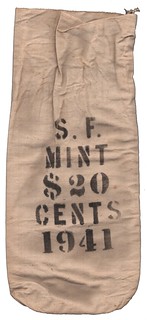 Recently, a long-time friend of mine who deals in all sorts of numismatica emailed me to say he'd sold some U. S. Mint canvas bags on eBay and discovered that the buyer is an NGC grader. I confirmed that fact and mentioned that I, too, have a modest collection of Mint and Treasury bags. This prompted me to look for them in the valley of forgotten collectibles that is my hobby room. I'm attaching scans I made of some of the more interesting pieces.
Recently, a long-time friend of mine who deals in all sorts of numismatica emailed me to say he'd sold some U. S. Mint canvas bags on eBay and discovered that the buyer is an NGC grader. I confirmed that fact and mentioned that I, too, have a modest collection of Mint and Treasury bags. This prompted me to look for them in the valley of forgotten collectibles that is my hobby room. I'm attaching scans I made of some of the more interesting pieces.
The first is a bag that formerly held $20 in 1941-S cents. Some time ago there was a debate on one of the message boards about whether cents were shipped in less than $50 quantities, and I mentioned having this bag. I find it particularly amusing that the font of the "S" in the word "CENTS" printed on the bag is similar in style to the somewhat scarce Large S variety of 1941-S cents---probably just a coincidence.
MORE ON ZERBE AND THE 1909 ANA ELECTION
Douglas Ward of Santa Ana, CA submitted this article on Farran Zerbe and the 1909 ANA election, rebutting a number of claims made over the years against Zerbe as addressed in David Alexander's 2016 CoinWeek article on the topic. -Editor
VOCABULARY TERM: JUGATE
Here's another entry from Dick Johnson's Encyclopedia of Coin and Medal Terminology. -Editor
Jugate. Two or more portraits joined side-by-side and overlapping to form the device appearing on one side of a numismatic item. The portraits face the same direction and the term is similar to accolated and conjoined, opposite of vis-a-vis (where the heads are facing each other). The term for one or more heads on both sides of a numismatic item is bijugate. See also portraits and portraiture.
Reference:
NE42 {1982} Doty, p 182-183.
FRANK JOHN JOSEPH (1838-1895)
American Numismatic Biographies author Pete Smith submitted this article on Canadian collector Frank John Joseph. Thanks. -Editor
This week I came across an unfamiliar name that got my attention. Of Frank John Joseph,
Wikipedia stated Reportedly had one of the finest private collections of coins and medals in
North America worth an estimated $30000 at his death.
He was not mentioned by Attinelli (A
Bibliography of American Numismatic Auction Catalogues 1828-1875); not mentioned by
Bowers (American Numismatics Before the Civil War); not in the Centennial History of the
A.N.A. In fact, I did not find him in any book in my library.
HARVEY STACK'S NUMISMATIC FAMILY, PART 124
Stack's Bowers has a backlog of the late Harvey Stack's numismatic memoir articles and will continue publishing them. In this one Harvey discusses sales from the second half of 1997. -Editor
Our 1997 auction season continued in May with a sale of nearly 1,200 lots of United States coins and paper money featuring the McGreevy Family and Bruce Lawrence collections. While not complete offerings, the quality was nicer than what was usually offered and there was great competition for both common and scarce items by bidders looking to fill holes in their collections. Interest and participation by both collectors and dealers continued to grow as the year went on. ?
ROSA AMERICANA COLONIAL COINS PRICE LIST #23
E-Sylum supporter Jeff Rock of Rosa Americana, LTD has issued a new fixed price list of U.S. colonial coins. Here's his summary description and some sample pages. Great material here, with excellent writeups. To get your copy, contact Jeff at rosaamltd@gmail.com . -Editor
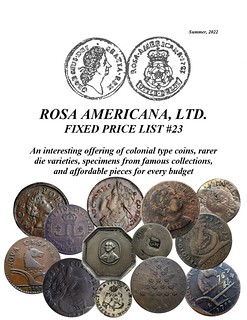 Certainly something of a record for me, this 23rd Fixed Price List of interesting and
affordable colonial coins, tokens, and medals follows fast on the heels of my 22nd list which
came out just four months ago. For those of you who have been on my mailing list for years (or
even decades) you know that lists were often spaced many years apart – one of my goals in
moving from those mammoth lists of 600-700 coins was to put out smaller, more frequent lists,
which has been the case since my 20th Price List, issued in digital format (issued in 2019, 9 years
after the 19th price list was put in the mail!). This smaller number of coins per list means that I
can get the writing done faster, while the digital format makes it feasible to have larger-sized,
high quality, full color photographs of every coin. Because I'm not spending money on printing
and postage it also means that I can go into far greater detail, devoting an entire page of photo
and text to a coin that may have a price of just a couple hundred dollars.
Certainly something of a record for me, this 23rd Fixed Price List of interesting and
affordable colonial coins, tokens, and medals follows fast on the heels of my 22nd list which
came out just four months ago. For those of you who have been on my mailing list for years (or
even decades) you know that lists were often spaced many years apart – one of my goals in
moving from those mammoth lists of 600-700 coins was to put out smaller, more frequent lists,
which has been the case since my 20th Price List, issued in digital format (issued in 2019, 9 years
after the 19th price list was put in the mail!). This smaller number of coins per list means that I
can get the writing done faster, while the digital format makes it feasible to have larger-sized,
high quality, full color photographs of every coin. Because I'm not spending money on printing
and postage it also means that I can go into far greater detail, devoting an entire page of photo
and text to a coin that may have a price of just a couple hundred dollars.
ATLAS NUMISMATICS JULY 2022 SELECTIONS
Atlas Numismatics has updated their website with 366 new coins, medals, and tokens at fixed prices. Selections include the following items. -Editor
Mint State Caracalla Aureus
Ex Leu Auction 83, Zürich May 2002, Lot No. 791. $44,500
To read the complete item description, see:
Mint State Caracalla Aureus
(https://atlasnumismatics.com/1069263/)
SOVEREIGN RARITIES AUCTION 6 HIGHLIGHTS
Sovereign Rarities will hold their sixth auction next week. Here's the press release. -Editor
Sovereign Rarities are pleased to present to the numismatic community their sixth auction - taking place on the 28th June 2022 - consisting of 327 lots of Ancient, World, Historic and Modern British coins. The sale features many choice Ancient, British and World coins, and is Sovereign Rarities' inaugural timed auction open for bidding at www.sovr.co.uk from now until 10 am BST on the 28th.
The sale begins with lots 1-16, Ancient Greek, Roman and British coins, with a run of gold, silver and bronze material. Lot 1 is perhaps the highlight of this section, a silver 10 Litrai of Syracuse dating from 215-214 BC, graded by NGC as AU 5/5, 4/5. However, the prize for eye appeal may go to lot 3, a Skithian gold Stater of Koson from the mid-1 st century BC graded by NGC as MS 5/5 4/5.
SOLIDUS AUCTION 102 SELECTIONS
Here are some lots that caught my eye in the upcoming Solidus Auction 102. The descriptions are Google-translated from German. -Editor
WORLD BANKNOTE AUCTIONS SALE 28
Here's the press release for World Banknote Auctions upcoming Live Sale 28. Nice material, as always. -Editor
World Banknote Auctions has now listed Live Sale 28 on its website, which is divided in two sessions. Session 1 is our live session, and will be sold on July 7, 2022, with live bidding that day at 1 PM Eastern / 10 AM Pacific. Session 2 is a timed session that starts to end on Sunday, July 10 at 6 PM Eastern / 3 PM Pacific, with lots ending every 20 seconds (unless extended, please see the website for details). World Banknote Auctions Sale 28 offers a total of 945 lots of paper money from around the world. Some highlights are selected below but the entire catalog can be viewed on the company's website, www.worldbanknoteauctions.com
CLASSIC GOLD QUARTER EAGLE AND HALF EAGLES
An article by Joshua McMorrow-Hernandez on PCGS.com highlights classic gold Quarter Eagle & Half Eagle rarities. -Editor
The Classic Gold coins of the 1830s are often viewed by numismatists as the earliest issues of the United States pre-1933 gold catalog that remain approachable by collectors in terms of overall availability and price. These gorgeous gold coins, the artistic brainchildren of Chief Engraver of the United States Mint William Kneass, were produced in generally larger numbers than their predecessors and represent a transitional period in U.S. gold minting history when the nation was enjoying the yellow fruits of its first gold rush in the foothills of the Great Smoky Mountains.
To handle the increasing need for more gold coinage in a young and rapidly expanding nation, the U.S. Mint announced in the mid-1830s the construction of three new mints in New Orleans, Charlotte, and the small gold-mining town of Dahlonega in Georgia. These three mints — the first branch facilities of the U.S. Mint — came online by 1838, with gold coin production remaining an integral part of the duties at the mother mint
in Philadelphia. Even as mintages for Kneass' classic gold coinage reached into the six figures, survivors are relatively small in number, and especially so in higher grades.
NUMISMATIC NUGGETS: JUNE 26, 2022
Here's a selection of interesting or unusual items I came across in the marketplace this week. Tell us what you think of some of these. -Editor
Pre Civil War 1859 token Miller / Rulau Ma Bo 77 UNC Details with light hairlines from cleaning. Jos. H. Merriam Die Sinker 18 Brattle Square Boston Medals Struck In Gold, Silver, Copper Or Tin. Thomas Sayers Champion Of England 1859 (125-150).
Super Merriam diesinker business card from Steve Hayden's eBay listings. -Editor
To read the complete lot description, see:
1859 Boston Massachusetts Merchant Token Merriam Die Sinker Sayers Boxing Champ
(https://www.ebay.com/itm/384953635971)
Other topics this week include a 5th US Colored Troops Dog Tag and the Bank Note Cigar Tin. -Editor
WAYNE'S NUMISMATIC DIARY: JUNE 26, 2022
Tuesday June 21, 2022 was my first day back at the office following five days at home for our daughter's high school graduation festivities and a long holiday weekend. I was tired, but looking forward to the monthly dinner meeting of my Northern Virginia numismatic social group, Nummis Nova.
Our host for the evening was Jon Radel and he'd made a reservation at the Greek restaurant Nostos in Vienna/Tyson's Corner. Parking was getting tight but I found a spot and made my way to our table. I took a seat between Jon and Daryl Haynor. The remaining attendees were Mike Packard, Dave Schenkman, Eric Schena, Robert Hoppensteadt, Steve Bishop, Roger Burdette, and Julian Liedman.
THE BOOK BAZARRE
NUMISMATIC COMMEMORATIONS OF PRIDE
Nathan Elkins published an article on the American Numismatic Society Pocket Change blog on numismatic commemorations of Pride. -Editor
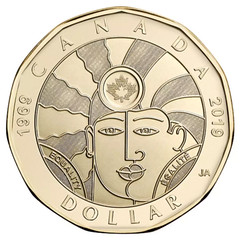 Numismatic commemorations of Pride and the challenges historically experienced by LGBTQIA+ community are, however, remarkably lacking. In fact, the first (and only) circulating coin to recognize the tribulations of the LGBTQIA+ community and its advances towards equality was struck in Canada in 2019. The one-dollar coin, sometimes referred to as the
Numismatic commemorations of Pride and the challenges historically experienced by LGBTQIA+ community are, however, remarkably lacking. In fact, the first (and only) circulating coin to recognize the tribulations of the LGBTQIA+ community and its advances towards equality was struck in Canada in 2019. The one-dollar coin, sometimes referred to as the gay loonie,
depicts two intertwined faces and the phrases EQUALITY and ÉGALITÉ. While the Royal Canadian Mint sold colorized variations and proofs of this coin directly to collectors, three million were struck for general circulation. The coins marked 50 years since Canada's partial decriminalization of homosexuality and referred to the LGBTQ2 movement; in Canada the 2
in LGBTQ2 refers to the two-spirit concept among native peoples, of having both masculine and feminine qualities, which some indigenous people in Canada have deployed as a means of describing their own gender identities. While many welcomed the gay loonie,
it was also criticized by some as suggesting that the work for LGBTQIA+ equality is complete; some conservative religious groups were offended that the LGBTQIA+ community was recognized on official currency.
EAST INDIA COMPANY GODDESS HERA GOLD COIN
The East India Company commissioned coin designer Joel Iskowitz to create a series of coins on the Goddesses of Ancient Greek and Norse mythology. Great design! -Editor
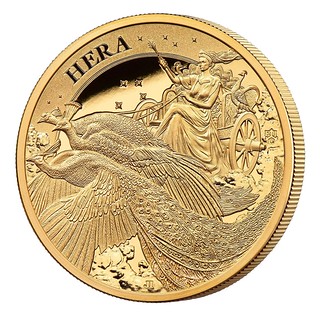 East India Company Collections introduces a new coin series which will tell the stories of the Goddesses of Ancient Greek and Norse mythology.
East India Company Collections introduces a new coin series which will tell the stories of the Goddesses of Ancient Greek and Norse mythology.
Despite originating in ancient myths and legends, Goddesses inform modern life perhaps more than we realize. Their mythology, religious legends, history and folk tales influence movies, TV shows, museum exhibits and famous brands such as cameras and running shoes.
Theirs are stories of intricate family sagas, wars fought by powerful dynasties, love found and lost, the worlds of nature and magic and the realms of gods and men, featuring fantastical creatures and characters who inspire our imaginations and codes of living. Morals, virtues, beliefs and ethics are all integral to the mythology of the Goddesses.
TIFFANY COMMISSION SCRIP
The June 2022 issue of Nena News from the New England Numismatic Association has a nice article by Gary E. Lewis titled "Panic of 1873 In New England." It's about Tiffany commission scrip, produced for New England merchants following the financial Panic of 1873. With permission, we're republishing it here. Many thanks to John Ferreri for assistance. -Editor
The period following the Civil War was a time of expansion and rapid growth for New England. New industries like milling, lumber, fishing, and other enterprises all formed what is now known as the Golden Age.
As most numismatists know, currency in the 1870's and for most of the
nineteenth century was based on specie. Metal money circulated in New
England, and many local state banks issued paper banknotes backed by
the supply of gold and silver. This system changed due to financial demands imposed by the Civil War. President Lincoln authorized the printing of Demand Notes in 1861, called Greenbacks
, to pay the ballooning expenses of the war.
BRITAIN'S SWITCH TO POLYMER BANKNOTES
Arthur Shippee passed along this Washington Post article about Britain's switch to polymer banknotes. -Editor
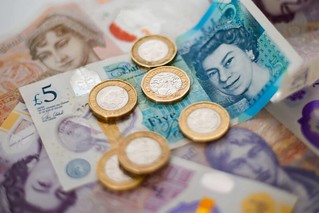 Britain's Central Bank will remove bank notes worth 14.5 billion pounds, or nearly $18 billion, from circulation by Sept. 30, as it seeks to retire its remaining paper currency in favor of polymer bills. The transition will make Britain the world's largest economy that uses only plastic-like bank notes.
Britain's Central Bank will remove bank notes worth 14.5 billion pounds, or nearly $18 billion, from circulation by Sept. 30, as it seeks to retire its remaining paper currency in favor of polymer bills. The transition will make Britain the world's largest economy that uses only plastic-like bank notes.
The Bank of England urged people holding paper 20- and 50-pound bills to spend or deposit them with a financial institution before they are no longer legal tender. Retail outlets will no longer accept them starting in October, but banks and the U.K. Post Office may continue to do so. Britain is one of Europe's most cashless societies, with many consumers switching to digital and card payments during the coronavirus pandemic.
FEDERAL RESERVE NOTE GOLD BACKING
Wayne Pearson submitted these notes on the redeemability of Federal Reserve Notes in gold. Thanks. -Editor
Once upon a time, in 1929, Federal Reserve Notes (1928 series) were backed by gold. In this $5 example, read what it says on the upper left.
THE WAL-MART COIN-COVERED CADILLAC
Greg Burrus of Chattanooga writes:
"I saw this Cadillac on Reddit the other day and found a few other sites with details about it. I wanted to send it along as it might be of possible interest (that is, if it's not been shared already). Thanks for a great newsletter!"
I don't believe we've discussed this one before - thanks! -Editor

